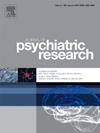Altered thyroid function and neurometabolic features provide clues to understand the comorbidity of bipolar II depression and obsessive-compulsive disorder
IF 3.7
2区 医学
Q1 PSYCHIATRY
引用次数: 0
Abstract
Bipolar disorder (BD) is highly comorbid with obsessive-compulsive disorder (OCD), leading to poor treatment outcome and prognosis. However, the neurobiological mechanisms underlying BD comorbid with OCD remain poorly understood. To address it, we recruited 69 untreated patients with bipolar II depression, including 35 comorbid with OCD (BD-II-Depression-OCD) and 34 without OCD (BD-II-Depression-nonOCD), and 38 healthy controls (HC). Serum thyroid hormones levels and neurometabolic ratios, including N-acetyl aspartate (NAA), choline-containing compounds (Cho), and creatine (Cr), were detected to explore the neuroendocrine and neurometabolic mechanisms of BD-II-Depression-OCD comorbidity. Multivariate logistic regression and restricted cubic spline analyses were performed to identify influential factors for comorbidity and their nonlinear relationships with symptom severity. Our results revealed that patients with BD-II-Depression-OCD demonstrated reduced thyroid-stimulating hormone (TSH) levels, decreased NAA/Cr in the left prefrontal white matter (PWM), and increased Cho/Cr in the right PWM compared to patients without comorbidity. These parameters demonstrated diagnostic potential for distinguishing BD-II-Depression-OCD comorbidity. Furthermore, nonlinear associations were observed between obsessive-compulsive symptom severity and both serum TSH levels and right PWM Cho/Cr ratios among patients with comorbidity. In conclusion, BD-II-Depression-OCD comorbidity is characterized by distinct thyroid dysfunction and neurometabolic alterations. Disruptions in serum TSH levels and bilateral PWM neurometabolism may represent potential mechanisms underlying BD-II-Depression-OCD comorbidity.
求助全文
约1分钟内获得全文
求助全文
来源期刊

Journal of psychiatric research
医学-精神病学
CiteScore
7.30
自引率
2.10%
发文量
622
审稿时长
130 days
期刊介绍:
Founded in 1961 to report on the latest work in psychiatry and cognate disciplines, the Journal of Psychiatric Research is dedicated to innovative and timely studies of four important areas of research:
(1) clinical studies of all disciplines relating to psychiatric illness, as well as normal human behaviour, including biochemical, physiological, genetic, environmental, social, psychological and epidemiological factors;
(2) basic studies pertaining to psychiatry in such fields as neuropsychopharmacology, neuroendocrinology, electrophysiology, genetics, experimental psychology and epidemiology;
(3) the growing application of clinical laboratory techniques in psychiatry, including imagery and spectroscopy of the brain, molecular biology and computer sciences;
 求助内容:
求助内容: 应助结果提醒方式:
应助结果提醒方式:


